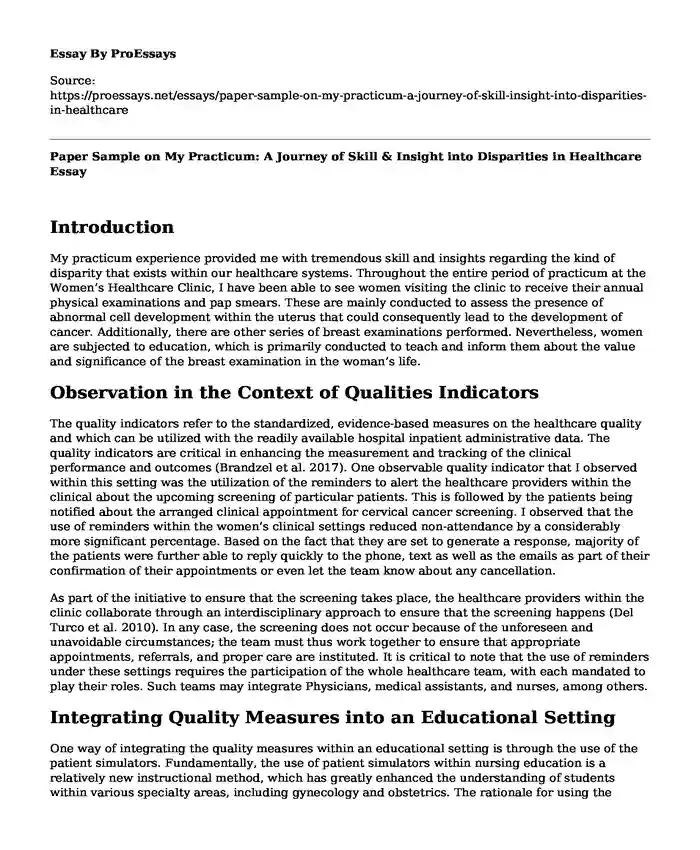Introduction
My practicum experience provided me with tremendous skill and insights regarding the kind of disparity that exists within our healthcare systems. Throughout the entire period of practicum at the Women’s Healthcare Clinic, I have been able to see women visiting the clinic to receive their annual physical examinations and pap smears. These are mainly conducted to assess the presence of abnormal cell development within the uterus that could consequently lead to the development of cancer. Additionally, there are other series of breast examinations performed. Nevertheless, women are subjected to education, which is primarily conducted to teach and inform them about the value and significance of the breast examination in the woman’s life.
Observation in the Context of Qualities Indicators
The quality indicators refer to the standardized, evidence-based measures on the healthcare quality and which can be utilized with the readily available hospital inpatient administrative data. The quality indicators are critical in enhancing the measurement and tracking of the clinical performance and outcomes (Brandzel et al. 2017). One observable quality indicator that I observed within this setting was the utilization of the reminders to alert the healthcare providers within the clinical about the upcoming screening of particular patients. This is followed by the patients being notified about the arranged clinical appointment for cervical cancer screening. I observed that the use of reminders within the women’s clinical settings reduced non-attendance by a considerably more significant percentage. Based on the fact that they are set to generate a response, majority of the patients were further able to reply quickly to the phone, text as well as the emails as part of their confirmation of their appointments or even let the team know about any cancellation.
As part of the initiative to ensure that the screening takes place, the healthcare providers within the clinic collaborate through an interdisciplinary approach to ensure that the screening happens (Del Turco et al. 2010). In any case, the screening does not occur because of the unforeseen and unavoidable circumstances; the team must thus work together to ensure that appropriate appointments, referrals, and proper care are instituted. It is critical to note that the use of reminders under these settings requires the participation of the whole healthcare team, with each mandated to play their roles. Such teams may integrate Physicians, medical assistants, and nurses, among others.
Integrating Quality Measures into an Educational Setting
One way of integrating the quality measures within an educational setting is through the use of the patient simulators. Fundamentally, the use of patient simulators within nursing education is a relatively new instructional method, which has greatly enhanced the understanding of students within various specialty areas, including gynecology and obstetrics. The rationale for using the simulation as an educational strategy includes the absence of risk to live patient, and the ability to offer case standardization (Durham & Alden, 2008). It also promotes critical thinking and various clinical decision-making within the clinical settings.
Conclusion
Through the patient simulation within the Women’s clinic where I undertook my practicum, I observed that it is possible to emphasize the essential elements of patient safety, such as the prevention of medication errors, effective communication, and enhanced teamwork. The provision of a variety of exposures to students within several clinical situations enables them to be better equipped towards the provision of safe, effective care and work as contributing members of the healthcare fraternity (Durham & Alden, 2008).
References
Brandzel, S. D., Bowles, E. J. A., Wieneke, A., Bradford, S. C., Kimbel, K., Gao, H., & Buist, D. S. (2017). Cancer screening reminders: addressing the spectrum of patient preferences. The Permanente Journal, 21. https://www.ncbi.nlm.nih.gov/pmc/articles/PMC5638633/
Del Turco, M. R., Ponti, A., Bick, U., Biganzoli, L., Cserni, G., Cutuli, B., ... & Mano, M. P. (2010). Quality indicators in breast cancer care. European journal of cancer, 46(13), 2344-2356. https://link.springer.com/article/10.1186/2045-4015-1-3
Durham, C. F., & Alden, K. R. (2008). Enhancing patient safety in nursing education through patient simulation. In Patient safety and quality: An evidence-based handbook for nurses. Agency for Healthcare Research and Quality (US). https://www.ncbi.nlm.nih.gov/books/n/nursehb/ch51/?report=reader
Cite this page
Paper Sample on My Practicum: A Journey of Skill & Insight into Disparities in Healthcare. (2023, Sep 25). Retrieved from https://proessays.net/essays/paper-sample-on-my-practicum-a-journey-of-skill-insight-into-disparities-in-healthcare
If you are the original author of this essay and no longer wish to have it published on the ProEssays website, please click below to request its removal:
- Causes of Alzheimer's Disease Essay
- Influence of Physical Activity on Cognitive Development and Functioning in Children - Paper Example
- Memorable Day in My Life Essay Example
- Hospital Billing System: Reimbursement of Medical Services - Essay Sample
- Essay Example on Jean Watson's Caring Theory: Enhancing Healing and Satisfaction
- Antibiotic for Treating Tuberculosis - Essay Example
- Ultrasound Applications Beyond Radiology: Critical Role in COVID-19 Diagnosis and Management







